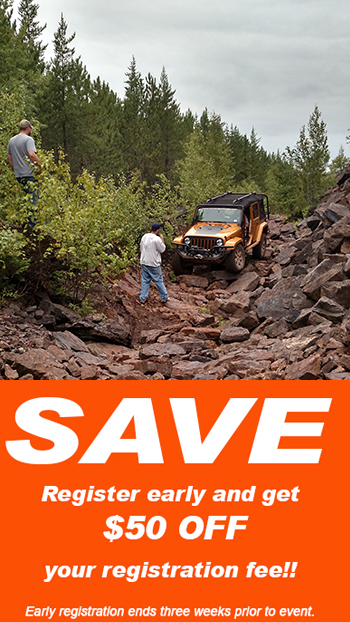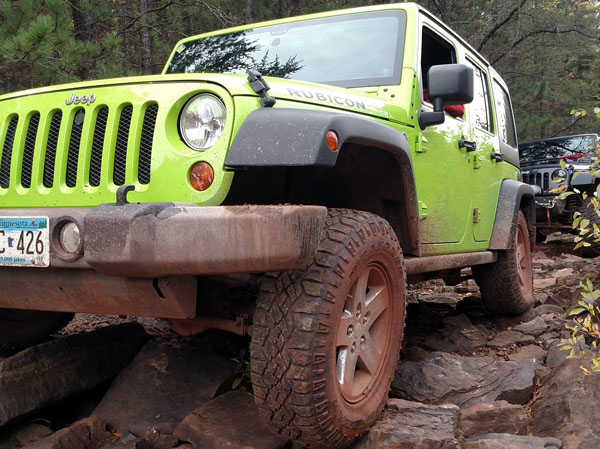Buy a canvas tarp. A real one. Military style. None of that blue plastic. Thick and a little musty. Don't know where to find one? Figure it out, because you'll go back there to buy other stuff later.
OK. Let's start learning some offroad driving tips.
Spread that tarp out under your Jeep. Now you know why I recommended a thick one. It's more comfortable.
It's time to understand what's down there so you can wheel with a little more confidence and enjoy your outdoor time a little more stress-free.
Find the steering box. It has a pitman arm coming out which connects to a drag link which connects to one steering knuckle. There's also a tie rod which connects the two front wheels together. That tie rod is vital (if steering is important to you). It’s right there in front of the axle, so we will have to take care to avoid bashing it on the trail.
Find the oil pan and note the skid plates. See the exhaust coming off the manifold? Remember where that pipe turns to go to the back of the vehicle.
The differential is the lowest part of the Jeep. Is it offset on the left or right side? That’s also good intel to have on the trail.
Control arms hang down off the frame. They'll probably make contact with something sometime. Good thing they're beefy, but aftermarket pieces are even thicker. Something to think about when contemplating future upgrades.
How about the brake lines? They should be tucked up, and not stretched tight.
There are 2 driveshafts sticking out of the transfer case. Try grabbing them and twisting and shaking them. Any play? There should be just a little.
Welcome to the greasy side of your Jeep. Making friends with these parts is an important part of learning to wheel.
Now that we know what is under the Jeep, let's start to learn exactly how big it is. Set up a few soft markers. I use a plastic garbage can, but cones are great, too. Keep them soft, because you'll make contact a few times.
What does it feel like driving right next to the marker? Get close. Even closer. On the trail, you might squeeze between 2 trees with only inches to spare. Can you back up right to the marker? Get out and look. Still had almost a foot! The goal here is to get a feel for how close things actually are. In a controlled condition with soft obstacles, you can be wrong without wrecking anything. That also helps build confidence.
Now, let's put some rocks into the game. Small rocks (the size of a brick) that you can easily roll over, but certainly "feel" when you do. Can you put your driver front tire on target? How about the passenger side? Can you position the rear tires every time? That's a little trickier. It's a skill worth practicing because on the trail you'll need to put your tires on top of rocks (to protect all those vulnerable things we met while laying on our tarp). You’ll now realize that (unless you’re traveling in a perfectly straight line), the rear tires don’t always follow the front tires.
At this point you're thinking let's head out and do this...I am so ready!
Not so fast.
Spend some time getting your gear together.
Got recovery stuff (gloves, a shovel, tow strap with looped ends, Hi-Lift jack, etc.)? Pack it.
Got tools? Not everything in your garage, but at least a few strategic items. Duct tape and WD-40 should be in your kit also. Bring your own tire pressure gauge. Pack a big trashbag. You are responsible for packing out whatever you packed in (and you’ll probably be able to pack out some things previous people left behind).
Need raingear? Boots? Sunscreen? Bug dope? A jacket and sleeping bag? First Aid Kit? Extra fuel? Food and water? Softdrinks are ok, but leave the beer and booze at home. Where we're going, you'll want a clear head.
See? We weren't even close to being ready to go yet.
One of my most important rules of offroad travel is to never go alone. I prefer at least 3 vehicles in a group. That way one can get stuck, another can get broken, and you still have a vehicle to get out and get help. A simple FRS radio is cheap and really effective for short range conversations with your buddies. Since they often come in 2 packs, you’ll either have a spare to share (or a backup when the batteries are depleted).
If you're meeting other wheelers online, remember that not everyone is interested in the same experience you are. Some guys swear if you're not breaking parts, you're not “trying” hard enough. Other groups are so mild that shifting into 4WD on gravel is as much excitement they can handle. Choose wisely and bail out if the group is not right for you. A beginner class is a great place to meet other novice drivers and develop a set of common baseline skills.
Once you get to the trailhead, grab that tarp (to protect your knees) and start airing down tires. It’s remarkable how much traction increases with this simple technique. I tell people to start at 15 psi, and experiment from there. If you have a reliable source to air back up (one of your buddies might be carrying a compressor or air tank), you can go even lower. Many folks are concerned about peeling beads. I run 8 psi and rarely have problems. You lose a little ground clearance once the tires “squat”, but the traction improvement is well worth it. Slipping and spinning is tough on the trail, tough on the vehicle, and tough on the driver and passengers.
Before getting back to highway speeds, you MUST air back up to normal pressures. Catastrophic tire failure can result in loss of control, damage to the vehicle, and injury or death to the occupants. If you have to drive a short distance to a service station that has compressed air, take it easy. The squishy handling is a result of sidewall deflection (desirable on the trail, but not on the highway).
As you head out on the trail, remember these basic rules:
As slow as possible, as fast as necessary.
Momentum (not speed) can be your friend, but I tell people there is a direct link between your right foot and your wallet. Lots of throttle usually results in more expensive repairs.
Keep the vehicle behind you in sight.
Getting groups stretched out on the trail can be tough on a guide. When I hear, “did you turn left or right at the tree?”, I know things are about to go downhill. I am not suggesting you have to drive faster to keep up…the vehicle in front needs to slow down to maintain visual contact!
Use common sense.
It’s not as common as you might think. Simple things like “no drinking and driving on the trail”, “wear your seatbelt”, or “keep your hands, feet (and head) inside the vehicle at all times” are things I didn’t think I should have to say…but I still do.
Keep your load balanced and secured.
If you’ve ever watched a high speed crash video, you know anything loose inside the vehicle is a potential missile flying around inside. Less dramatic, but far more common is the simple stuff. A coffee cup, cell phone, or FRS radio that bounces under your feet distracts you from the most important job you have…concentrating on the trail ahead. A cooler, toolbox, and spare tire strapped to the roof dramatically affects the center of gravity. Pay attention to these details before you start rolling, so you can focus on more important tasks throughout the day.
Take pictures and give advice from a safe distance.
No one wants to get run over. Accidents happen when bad decisions escalate and get out of control. These are preventable if you maintain a bit of common sense and follow this rule (and hold the people with you accountable to it as well).
Listen to your spotter.
There is a limited amount you can see from the driver’s seat. The spotter, on the other hand, has a very different perspective and a great deal more intel. As a driver, you need to focus on your spotter. As a spotter, you need to be 360° observant and clear in your directions. And as a spectator, you need to respect that you are mostly a distraction to the communication between those two.
Know how deep that puddle (or stream) is BEFORE you enter.
Unless you see fresh tire tracks coming out the other side, you should really consider other options. Fast water can make shallow fording points very dangerous. Deep water can make any water crossing a potential calamity. I carry an old pair of waders and a wading staff because this is such an easy error to avoid. If getting deep is likely, there are a number of things you should do ahead of time to prepare (lengthen breather tubes, seal the distributor, relocate the airbox, remove carpeting, temporarily disable the fan, etc.) that will minimize the impact that deep water has on your vehicle.
Many of the best trail tips are simple and inexpensive. In this column, we touched on 3 P’s:
- Preparation (working off a comprehensive checklist) ensures you won’t forget anything important.
- Practice (both driving the Jeep well and practicing strong safety habits) demonstrates great trail leadership.
- Preventative Maintenance (understanding how it works and how it needs to be maintained) is another sign of a competent and responsible driver.
Do you have other trail tips you want to share? Send an e-mail to This email address is being protected from spambots. You need JavaScript enabled to view it..
Would you like to register for a class? Visit www.ironrangeoffroad.com
Are you on Facebook? Head over to the Iron Range Offroad page and click the Like button.
Iron Range Offroad offers a comprehensive training course geared toward entry level Jeepers that stresses safety and environmental responsibility. The classroom setting is the spectacular Iron Range OHV park, 3 hours north of Minneapolis and St. Paul. Trail riding is integrated with class modules covering trip preparation, vehicle maintenance and repair, driving skills for different terrain, extraction techniques, vehicle upgrades, and much more.












